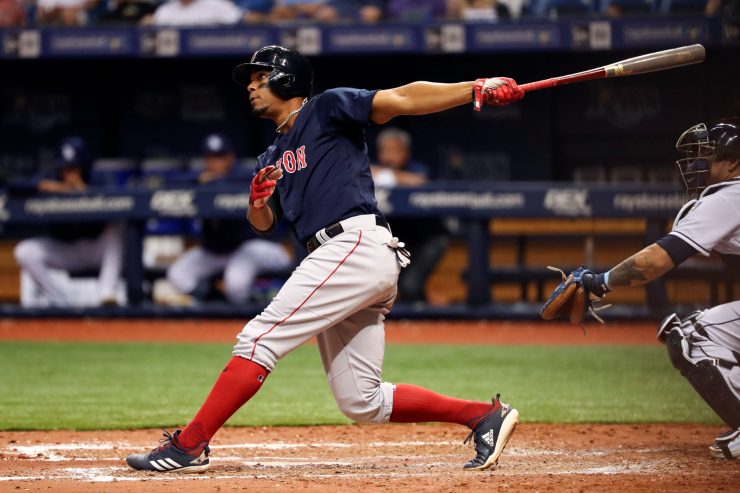The 2018 MLB regular season is only about a week old, so it wouldn’t be fair to draw any concrete conclusions about player performance. That doesn’t mean we still can’t make some early observations about certain players, though.
One player that has likely caught the eye of a few is Boston Red Sox shortstop, Xander Bogaerts — especially since he’s seemingly been allergic to singles up until this point. However, this isn’t the first time Bogaerts has enjoyed a great first week at the plate. He actually got off to a solid start in 2017, too.
But what makes his most recent performance different — and more impressive overall — when compared to last year?
Some Semblance of Power
When looking at the raw numbers, Bogaerts has gotten off to an almost identical start. He collected 10 hits in his first 27 plate appearances in 2017 and has needed just 28 plate appearances to register the same number of base hits this season. The big difference, though, is the kind of hits those are.
Last year, none went for extra bases en route to a 133 wRC+, .376 wOBA, and .844 OPS. In fact, Bogaerts didn’t even register his first extra-base hit until his eighth game played. It’s clear that 2018 is a whole different story so far. Six of his 10 hits have been of the extra-base variety (five doubles, one homer), which has led the young shortstop to a 178 wRC+, .423 wOBA, and 1.000 OPS.
Early Batted-Ball Transformation
It should go without saying that what we’ve seen thus far has been made possible because of a completely different batted-ball profile. Here’s a look at how Bogaerts’ line-drive rate (LD%), ground-ball rate (GB%), fly-ball rate (FB%), soft-hit rate (Soft%), and hard-hit rate (Hard%) compare since the 2016 season.
Comparing season-long numbers to a week’s worth of stats certainly isn’t fair because it takes much longer than that for a player’s performance to stabilize. However, it’s also worth noting that Francisco Lindor showed a drastic change in his batted-ball profile early last season, and he ended up hitting more homers in 2017 (33) than he did from 2015-16 (27).
Although we didn’t include the numbers above, Bogaerts’ early performance from this year looks way different upon comparing to the first six games of 2017. His 28.6% line-drive rate was high, but he owned a soft-hit rate (23.1%) that was higher than his hard-hit rate (19.1%), along with a 47.6% ground-ball rate and just a 23.8% fly-ball rate.
There is still a lot of work to be done for Bogaerts to prove that any of this progress will eventually be legit, but there’s nothing wrong with keeping it in the back of one’s mind. That’s especially a worthy action to take since J.D. Martinez — one of the fly-ball revolution poster boys — is now in Boston and likely having an impact in various ways.
Attack Mode
Among the many differences we’ve seen so far, probably the biggest of all is an increase in aggressiveness. Check out how Bogaerts’ plate discipline from 2018 compares to how he began his 2017 campaign.
While it’ll change soon, this aggressiveness has led to him drawing absolutely no walks. He only collected two during this period of time in 2017, but a jump of nearly 13 percentage points in chase rate displays something that could potentially become an issue if the trend continues.
The overall rate of contact has gone down, but since his batted-ball events and quality of contact have improved, comparatively speaking, he’s made a much greater offensive impact. Bogaerts’ current 11.7% swinging-strike rate is probably helping him since he’s not making contact with nearly everything, like he did last year (2.8% swinging-strike rate in his first six games).
Off on the Right Foot
For a player that dealt with a general lack of power in 2017 after displaying the potential to hit 20-plus home runs, this is an encouraging start. Getting hit on the wrist back in July certainly hampered his second-half performance, but we also need to remember that he’s still young.
Just because Bogaerts been around since 2013 doesn’t mean he’s old — the shortstop is still just 25 years old with theoretically his best years ahead of him. He’s shown a consistent ability to make contact, and if his early 2018 numbers are signaling some kind of a change, he’s in for a bounce-back season.
About Matt Musico
Matt Musico currently manages Chin Music Baseball and contributes to The Sports Daily. His past work has been featured at numberFire, Yahoo! Sports and Bleacher Report. He’s also written a book about how to become a sports blogger. You can sign up for his email newsletter here.
Add The Sports Daily to your Google News Feed!


